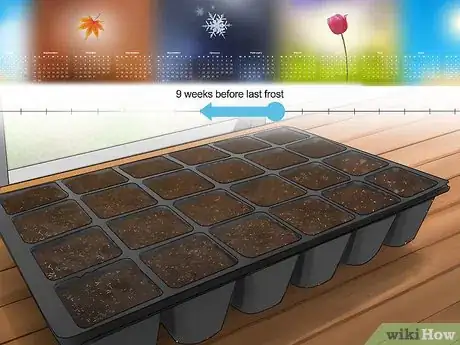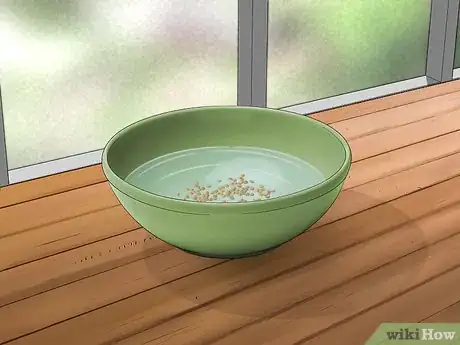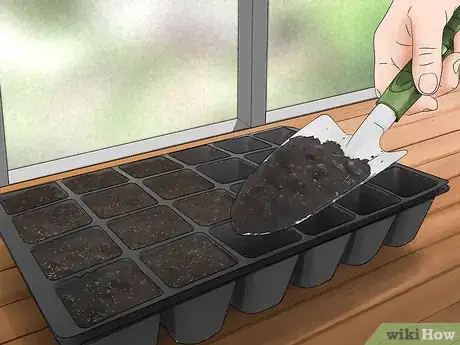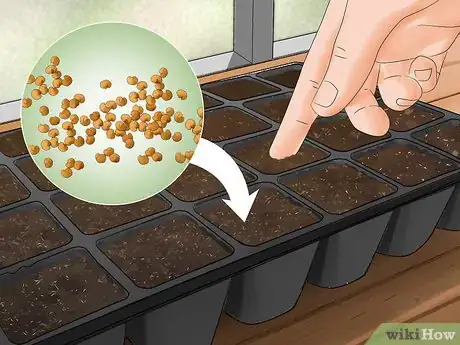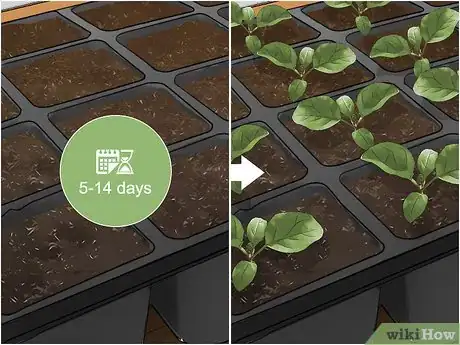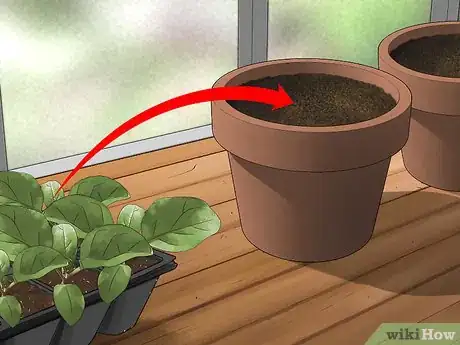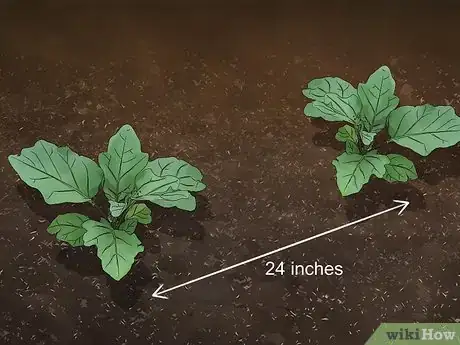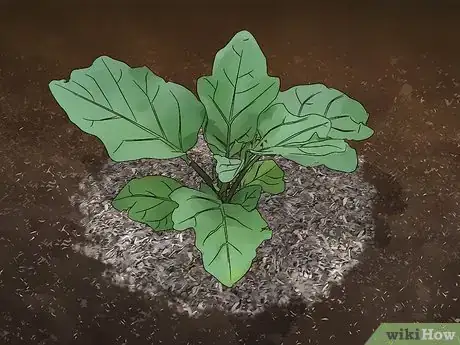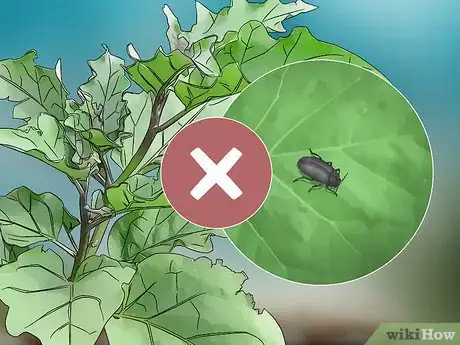This article was co-authored by Steve Masley. Steve Masley has been designing and maintaining organic vegetable gardens in the San Francisco Bay Area for over 30 years. He is an Organic Gardening Consultant and Founder of Grow-It-Organically, a website that teaches clients and students the ins and outs of organic vegetable gardening. In 2007 and 2008, Steve taught the Local Sustainable Agriculture Field Practicum at Stanford University.
There are 7 references cited in this article, which can be found at the bottom of the page.
This article has been viewed 45,940 times.
Eggplants are delicious, hearty vegetables that can make a great addition to your garden. Be sure to keep eggplants warm and watered to ensure their healthy growth. The plants will grow several feet in height and should be staked for support early in the growing process. After harvesting eggplant, you can enjoy it in a variety of dishes in a variety of dishes, including eggplant Parmesan and moussaka.
Steps
Starting Eggplant Seeds
-
1Start eggplant seeds indoors 6-9 weeks before the last frost is expected. Eggplants need warmth, so it is best to start them indoors and transplant them once the weather is warm enough. Aim to germinate the seeds 6-9 weeks before the last frost of the year is predicted. Eggplants should not be re-planted outdoors until the temperature is at least 70 °F (21 °C).[1]
- If you don't wish to plan ahead this way, you can purchase eggplant seedlings directly from a gardening center or nursery.
EXPERT TIPSteve Masley has been designing and maintaining organic vegetable gardens in the San Francisco Bay Area for over 30 years. He is an Organic Gardening Consultant and Founder of Grow-It-Organically, a website that teaches clients and students the ins and outs of organic vegetable gardening. In 2007 and 2008, Steve taught the Local Sustainable Agriculture Field Practicum at Stanford University.Home & Garden Specialist
 Steve Masley
Steve Masley
Home & Garden SpecialistLiving on a hill can affect the date of the last frost. According to the team at Grow it Organically: "The time of the last frost can vary a little based on the location of your garden. For instance, if your garden is down in the bottom of a hill, the cold air can settle in and you may have a later frost than you would if you were at the top of the hill."
-
2Soak the seeds overnight before germinating them. Eggplant seeds have a better chance of growing if they are soaked thoroughly before planting. Place the seeds in a small container and completely cover them with water. Let the seeds sit overnight, then drain the water.[2]
- Eggplant seedlings grow best in 72- and 128-cell trays, which have large seed containers that accommodate root growth.[3]
- Buy seed trays at garden centers or online.
Advertisement -
3Fill seed trays with a fine, loose growing medium. For the best results, germinate eggplant seeds in a soil-less growing medium. Fill seed trays 3/4 full with the growing medium of your choice. Vermiculite, perlite, coconut husk, and compost are all good options.[4]
-
4Plant the seeds 0.25 inches (0.64 cm) deep and moisten the medium. Using your fingers, push 1-2 eggplant seeds into the growing medium in each individual seed container. Make sure that the seeds are about 0.25 inches (0.64 cm) under the surface of the growing medium. Cover over the seeds and mist or sprinkle water onto the surface.[5]
-
5Let the seeds germinate for 5-14 days. Eggplants seeds will grow as soon as 5 days or in as long as 2 weeks, depending on the temperature they are kept at. Warmer temperatures will spur a quicker germination period. Try to maintain a temperature of at least 65 °F (18 °C) for your eggplant seeds while they are germinating.
-
6Transplant the seedlings into pots when they reach 3 inches (7.6 cm) tall. When the seedlings are large enough they should be given their own individual pots. Fill small pots with the same growing medium you used to start the seeds and dig small holes to insert the seedlings. Gently remove each seedling from the growing tray and replant them in their new pots.[6]
- The potted seedlings should be kept indoors until the outdoor temperature reaches at least 70 °F (21 °C).
Preparing the Planting Location
-
1Choose a spot in your garden that gets full sunlight. Eggplants require very high temperatures to grow and thrive in a garden. Ideally, choose a spot that gets sun for more than 6 hours per day to plant your eggplants. If this is not possible, plant eggplants in a spot that get only partial shade.[7]
-
2Do a test to see if your soil is well-drained. Eggplant grows best in healthy, well-drained soil. Find out what condition your soil is in by digging a hole that is approximately 12–18 inches (30–46 cm) deep and 12–18 inches (30–46 cm) wide, then fill the hole with water. If the water pools and takes longer than an hour to soak in, your soil is poorly-drained.[8]
-
3Fix poorly drained soil by adding an organic soil amendment. Use a gardening rake to loosen the top 8 in (20 cm) of your soil. Pour a 2 in (5.1 cm) layer of organic soil amendment on top of the soil. Use the rake to mix it into the soil evenly.
- Purchase organic soil amendment materials, such as sand, vermiculite, perlite, or compost, at a local garden center or hardware store.
Planting Eggplant Seedlings
-
1Plant seedlings 24–30 inches (61–76 cm) apart, root-deep. Eggplants do best when they have room to spread and grow. Dig holes slightly larger than your seedlings' roots, spaced 24–30 inches (61–76 cm) in all directions. Gently place the seedlings in the holes and fill the space around their roots with soil.[9]
-
2Place mulch material around the base of your plants. Mulching will help prevent the growth of weeds and keep your plants warm. Straw, compost, and grass clipping are good choices for natural mulch materials. Scatter them around the base of your eggplant seedlings in a thick layer.[10]
- Be sure to use grass clipping from untreated lawns, as chemicals and fertilizers may harm your plants.
- Layer at least 1 inch (2.5 cm) of mulch to protect your plants.
-
3Stake your plants to hold them up as they grow. Use bamboo sticks or other suitable stakes to hold up your plants. Insert the stakes into the soil about 1–2 inches (2.5–5.1 cm) away from each seedling. As the plants grow, they will lean onto the stakes and won't disturb any surrounding plants.[11]
- Insert the stakes right away after transplanting your seedlings to avoid disturbing the soil later on.
Caring for Eggplant as it Grows
-
1Water eggplants thoroughly once a week. To thrive, eggplant need at least 1 inch (2.5 cm) of water per week. Aim for one weekly, intensive watering rather that multiple, short watering sessions. Frequent watering promotes shallow roots, which can compromise the durability of your eggplants.
-
2Remove any flea beetles you find on the leaves of the plants. Flea beetles are tiny black insects that feed on plant leaves and can harm eggplant crops. Check the upper and lower leaves of your eggplants for these bugs and remove them by hand. Destroy the bugs to keep them from returning or reproducing.[12]
- If you are overwhelmed with flea beetles during the growing season, destroy your plants and cultivate the soil in the spring to destroy any larvae that may remain there.
-
3Use row covers to protect your eggplants. Row covers are great for protecting eggplants from the cold, disease, and insects. Row covers are long pieces of mesh material that cover plants and offer them protection. Lay row covers over your eggplants and fold over the edges on each side. Use a rubber mallet to hammer garden pegs through the folded edges of the material to secure it.[13]
- Lift the row covers to water your eggplants, and remove them completely when it's time to harvest.
- Purchase row covers at garden centers or online.
-
4Harvest eggplants 16-24 weeks after sowing when their skin is glossy. Keep track of your planting schedule from the day you first sow your eggplant seeds. At the 16 week mark, start checking your eggplant crops to see if they are ready for harvesting. When the skin is shiny, cut off eggplants near the stem with sharp pruning shears.[14]
- Eggplants will keep for 2 weeks if you refrigerate them.
Things You'll Need
- Seed trays
- Soil-less growing medium
- Eggplant seeds
- Small pots
- Shovel
- Organic soil amendment
- Gardening gloves
- Stakes (e.g. bamboo sticks)
- Row covers
- Garden pegs
- Rubber mallet
References
- ↑ https://www.goodhousekeeping.com/home/gardening/a20706884/growing-eggplants/
- ↑ https://www.goodhousekeeping.com/home/gardening/a20706884/growing-eggplants/
- ↑ https://extension.psu.edu/what-you-need-to-grow-healthy-transplants
- ↑ https://www.goodhousekeeping.com/home/gardening/a20706884/growing-eggplants/
- ↑ https://www.goodhousekeeping.com/home/gardening/a20706884/growing-eggplants/
- ↑ https://www.goodhousekeeping.com/home/gardening/a20706884/growing-eggplants/
- ↑ https://www.almanac.com/plant/eggplants
- ↑ https://www.bhg.com/gardening/yard/soil/what-is-well-drained-soil/
- ↑ https://www.goodhousekeeping.com/home/gardening/a20706884/growing-eggplants/
- ↑ https://www.goodhousekeeping.com/home/gardening/a20706884/growing-eggplants/
- ↑ https://www.almanac.com/plant/eggplants
- ↑ https://harvesttotable.com/eggplant_troubleshooting/
- ↑ https://rodaleinstitute.org/taming-the-floating-row-cover/
- ↑ https://www.almanac.com/plant/eggplants
- ↑ https://www.goodhousekeeping.com/home/gardening/a20706884/growing-eggplants/
About This Article
To grow eggplant, start by planting your seeds 6 to 9 weeks before the last frost is expected. For the best results, fill a seed tray with a non-soil growing medium, like vermiculite or compost. Then, plant 1 to 2 seeds in each container and wait for the seedlings to sprout, which can take up to 2 weeks. When the seedlings are 3 inches tall, transfer them into individual pots filled with the same growing medium you used in the seed tray. Once the outdoor temperature reaches 70 degrees Fahrenheit, you can plant your eggplant seedlings outside. Make sure to plant the seedlings 24 to 30 inches apart so they have room to spread and grow. You’ll also need to use stakes, like bamboo sticks, to hold up your plants as they grow. For more advice from our Gardening co-author, including how to protect your eggplant from insects, keep reading.
